Taking the Subway/ Metro in China
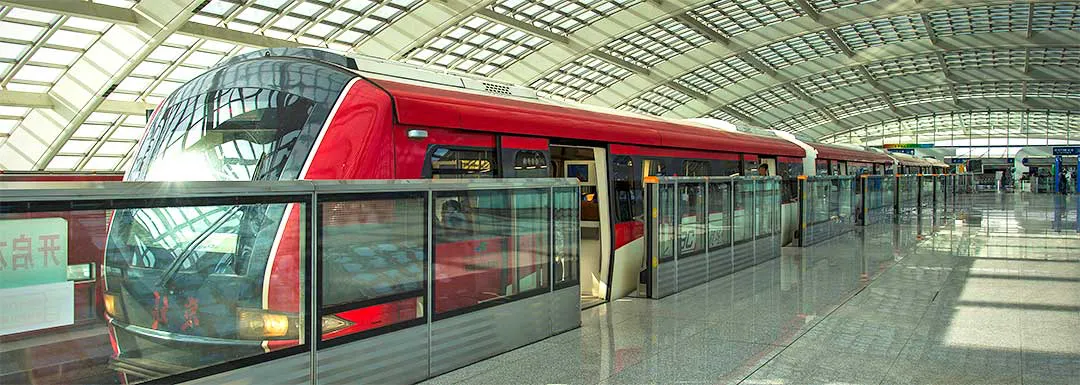
The subway is the fastest, nicest, coolest, and the most convenient way to move around any city in China. Modern, climate-controlled trains whisk you around the city quickly, efficiently, and best of all, very affordably. While taxis are affordable by western standards, you’d need to take several subway trips before equaling the cost of just one taxi ride. True, you’ll need to walk a little to get to your final destination, but most cities have subway systems with stops at most major (and even minor) popular destinations, so walking is rarely more than a few minutes.
Note: The terms “Subway” and “Metro” are both used in China. The term “Underground” is generally not used.
Getting out – the Exit is VERY important
Want to save time, energy, and massive headaches? Just follow this important tip.
Chinese subway stations have a minimum of two exits and large stations in large cities can easily have more than ten. Choosing the wrong exit (out of only two), can cost a person 5-10 minutes, a lot of walking, and a major headache as you try to gain your boundaries and figure out where you are and how you’re going to get to your destination. In large stations with four or more exits, the time wasted on choosing the wrong exit can cost someone upwards of a half hour and a lot of sweaty walking in the summer.
So, a word to the wise – when you get directions from someone that includes taking the subway, make sure you get the exact exit that you need and which way you should walk once out of the exit. Exits are usually labeled by letters A through J, for example.
Getting in
There is a general symbol for the subway/metro shown below. Additionally, each city has its own logo for their subway system, however, the logo is nearly always accompanied by the words “Subway” or “Metro” written underneath. Here are the symbols, and entrance/exit pictures, of several major subway systems in China.
General Symbol for the Subway/Metro in China

City-specific Subway/Metro Logos

Street Signs and Entrances

Ticket Purchasing / Frequent Rider Cards
Single Journey RFID Subway/Metro tokens
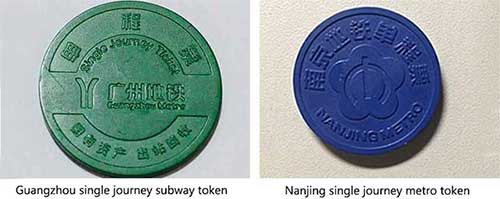
There are three ways to buy a ticket for the Subway.
1) Buy a single-trip token with the Automatic Ticket Machine, in English, with Touchscreen.
2) Buy a single-trip token from a person in any Customer Help booth
3) Buy a multi-trip card (purchased at select Customer Service booths)
Buy a single-trip token from the Automatic Vending Machine, in English, with Touchscreen.

Each subway station will have several electronic ticket machines with touchscreens.
1) The words will likely be in Mandarin. There should be a button labeled “English”. Touch it.
2) The rest of the process is basically following the directions on the screen. In general, you will locate your current station on the screen map and touch it. Then you will locate your destination stop and touch it. It will then display the fare. You will insert cash, coins, or credit cards (not all machines accept credit cards) and then a plastic token will be deposited in the tray.
3) To pass through the subway turnstile, simply touch the plastic token on the turnstile area and the gates will open. (The plastic token has an RF chip inside.)
4) When leaving the station, instead of touching the token on the turnstile area, you will see a coin slot where you need to deposit the token. Once deposited into the turnstile, the gates will open.
What happens if I miss my stop or change my mind and get off at a different stop?
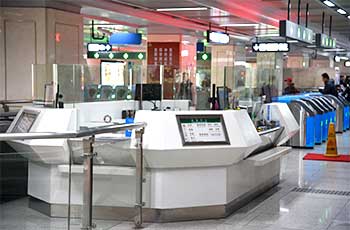 Subway customer service booth
Subway customer service booth Since your trip is prepaid, you are supposed to exit only at the stop you selected when buying the token. However, if you change your mind or otherwise miss your stop and there is a difference in the fare, the gates will not open when you deposit your token and instead the token should pop out in a lower slot. Take the token to the nearby customer service booth (always located with access for those “inside” the subway turnstiles and “outside”), give the token to the assistant, and they will usually understand there is an issue with it. They’ll then scan your token and show you on a screen what you owe. If they determine there is no extra fee charged, they will either physically open a nearby door to manually let you out or give you a new token to go back to the turnstile to deposit.
Incidentally, there are generally no refunds given, so if you get off early, you won’t receive a refund for the extra amount you paid. However, subway trips rarely cost more than $1.50 USD with the minimum charge of around $.40 USD – meaning at most, you could lose $1 USD.
Buy a single-trip token from a person in any Customer Service booth
1) If you want to avoid the automatic machines, you can also buy a one-way ticket/token straight from the customer service booth. Assistants in the booths are able to speak and understand various levels of English – some fairly decent while others extremely basic.
2) Say, or show, the name of the stop where you want to get off and they will tell you the price, accept the payment, and hand you the token.
Buy a multi-trip card (purchased at select Customer Service booths)
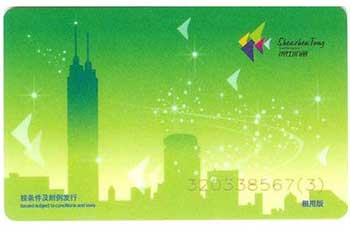 The multi-trip card
The multi-trip card To avoid some hassle and have more flexibility with your subway trips (you can get off at any station you feel like with no extra hassle), it pays to get a multi-trip card. It works as a prepaid card that you simply “touch and go” every time you enter and leave the subway. Plus, when paying using the card, you get a small discount on the fare – usually a whopping 5%.
1) To buy the card, you will need to go to a Customer Service booth and request one. The cards strangely are not always sold at every subway station, so you may need to hunt and peck a little to find one who offers it. In general, major stations (those where more than one line passes through) should have it. You will top it up at the moment you ask for it (about 50- 100¥). There is usually no charge for the card itself, however, they may require a small deposit (which you will get back if you return the card prior to leaving the city). More money can be easily added as necessary. Cards will only work in the city where they are purchased.
2) Following the above instructions, to enter and exit the subway, simply touch the card to the area on the turnstile and the gate will open. If you are unsure your first time, just watch someone else. Exiting is just as easy – just touch and go.
3) Many cities have a combined public transportation system meaning the card will also work on the city buses … and they’ll still give you the discount.
Prices
Ordinary lines, in most cities, cost 3-9¥ depending on the distance traveled for a single trip. Round trips will require two, single trips.
Pick the right Platform – Riding the Subway 101
For those travelers who have never, or rarely, taken a subway, here’s a crash course on how to navigate the system.
Important Notes:
- Most cities in China have multi-line subway systems. This means that to arrive at your destination, it’s likely you’ll have to change trains at least once.
- Each train line is colored coded and uses the English numbering system 1-10. This makes it easy for non-Mandarin speaking travelers to navigate any subway system in China.
- Subway maps, found inside the trains and all over the stations, use both Chinese characters and their Pinyin counterparts (Pinyin is Chinese written using the Roman alphabet) which allows English-speaking travelers to recognize names.
TIP: The key to navigating any subway system is knowing the name of the last stop on that line.
Six Basic Steps
1) Enter the subway and locate a map.
2) Find the name of the station where you are located.
3) Find the name of the station where you want to get off.
4) To choose the right platform, also locate the name of the last stop going in the direction of your destination.
5) Find the name of that destination written on the platform - usually above the area on the platform where the train stops. Get on that train.
6) Once on the train, pay attention to the stops and get off at your destination. Most Chinese subways use tiny LED lights on paper maps inside the train cars, or electronic maps, which indicate exactly where the train is.
Two examples.
Single Line trip
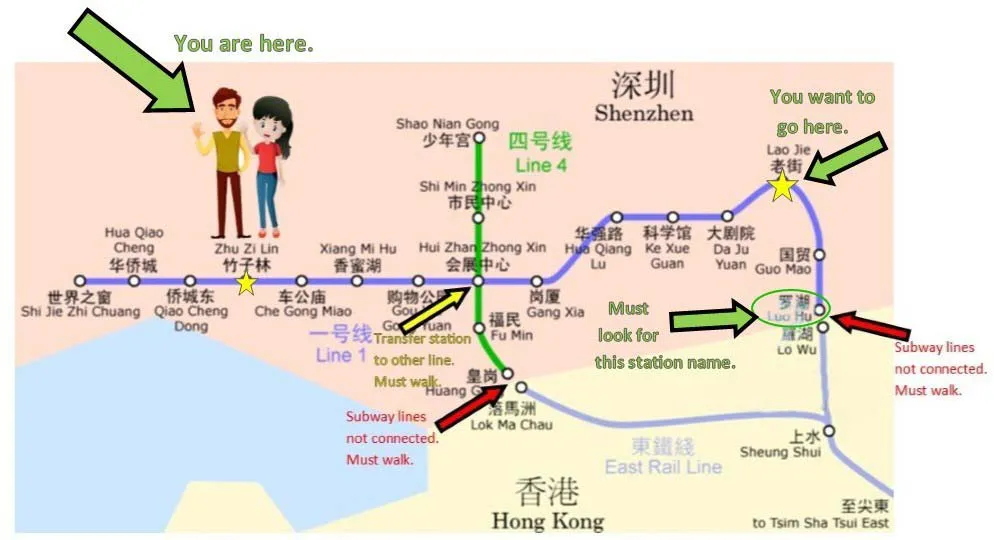
Example Above:
1) You are at Zhu Zi Lin and you want to go to Lao Jie.
2) Because your location and your destination are on the same line, you don’t have to transfer to another train line.
3) Once on the platform, locate the last stop on the way to your destination, which here is Luo Hu.
4) Find the name Luo Hu on the platform. This is the train you need.
5) If the train is crowded, watch the map inside the train and start making your way towards the door once the train passes the stop just before your destination. In this case, keep an eye out for Da Ju Yuan and head towards the door as soon as people start getting off so you’ll be close to the door once the train arrives at Lao Jie.
Multi-line trip
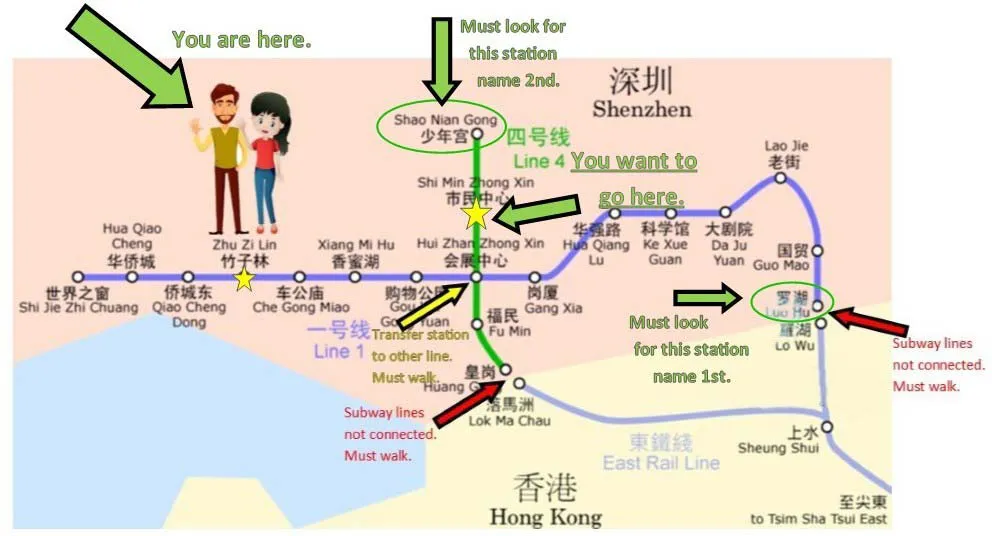
Example Above:
1) You are at Zhu Zi Lin and you want to go to Shi Min Zhong Xin.
2) Because your location and your destination are on different lines, you must transfer to another train line. This usually includes taking a few escalators, elevators, or stairs and anywhere from 1-5 minutes of walking. Occasionally, the new line is located just above or below the platform where you get off the incoming train.
3) Locate the last stops on the way to your destination on BOTH lines.
a) First, you need to take Line 1 (Blue line) to the station Hui Zhan Zhong Xin in order to pick up the Line 4 (Green line). To get the correct train on Line 1, find the last stop going in your direction, which here is Luo Hu.
b) Find the name Luo Hu on the platform. This is the train you need.
4) Once at Hui Zhan Zhong Xin, get off and look for signs directing you to Line 4. Follow the signs until you have arrived at Line 4.
a) Once on the platform, find the name of the last stop going in your direction. In this case, it’s Shao Nian Gong.
b) Find the name Shao Nian Gong on the platform and take this train. In this example, you only have to go one stop before exiting the train at Shi Min Zhong Xin.
5) If the train is crowded, watch the map inside the train and start making your way towards the door once the train passes the stop before your destination. In this case, keep an eye out for Gou Wu Gong Yuan on Line 1 and head towards the door as soon as people start getting off so you’ll be close to the door once the train arrives at Hui Zhan Zhong Xin. Once on Line 4, stay near the door as you’ll be getting off at the next stop.
Important Mandarin Characters
With so many names, words, and messages listed in both Roman and Chinese characters, it’s doubtful that most travelers will need to recognize Chinese characters; however, in case there’s a need, here are a few characters that can be helpful with some notes and tips on how to recognize them.
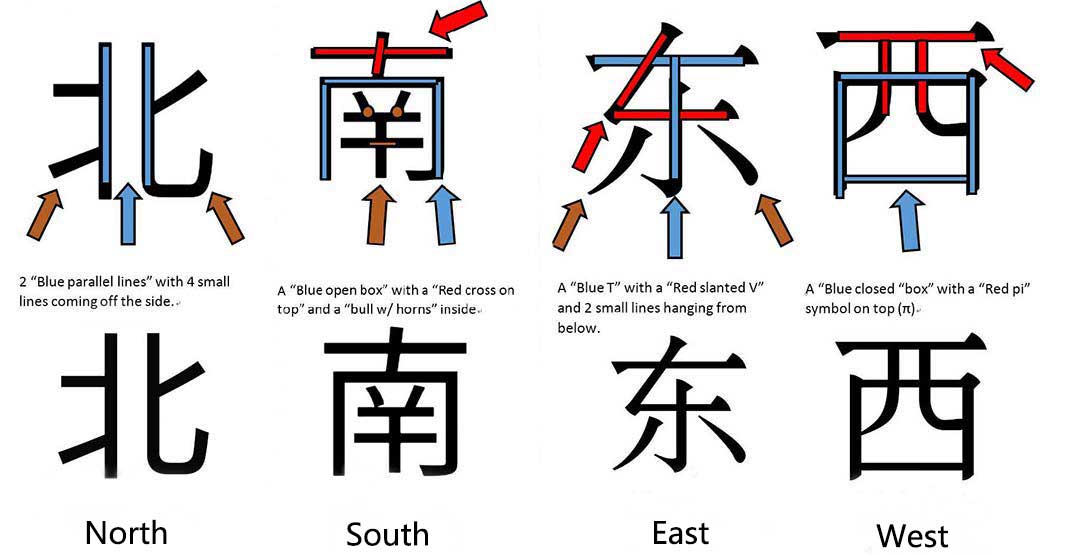
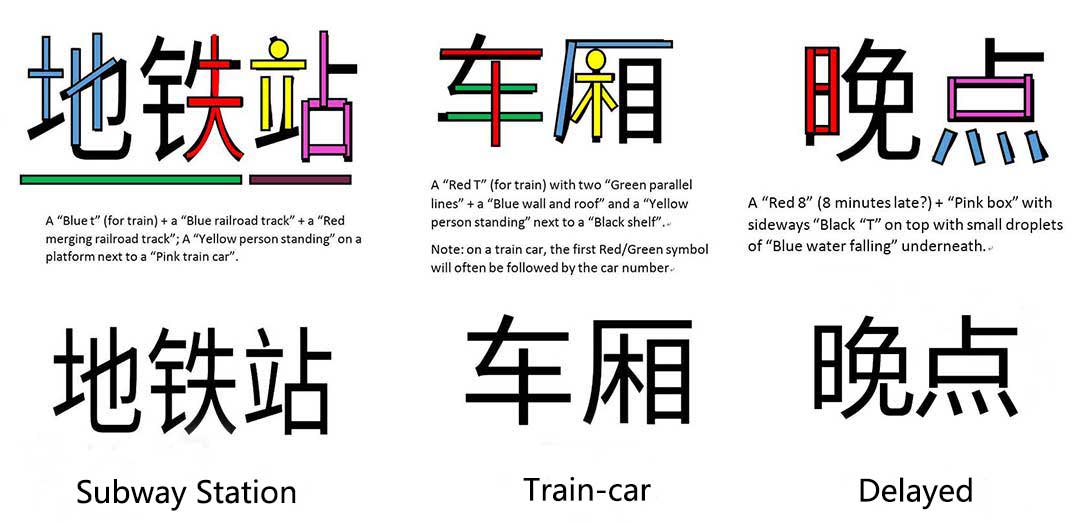
Quality & Safety
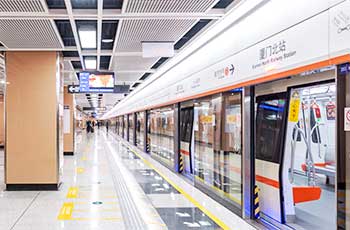 Subway Station
Subway Station China’s subway system, for every city, has been mostly built over just the last 30 years, with many being completed only since 2005. In fact, many cities are currently building and completely brand-new lines as their subway systems expand. This means that nearly every subway line is practically state-of-the-art. Trains are brightly lit, quiet, smooth, and perfectly climate controlled. Stations are also brightly lit, new, clean, and well attended.
Taking the subway, even at night, is extremely safe mostly due to the station’s ample lighting and security guards. Westerns who are used to doggy, dingy, or poorly lit subways with no security are in for a treat. China’s subways are the complete opposite.
Punctuality and Frequency of Trains
Punctuality – While there may be some variance between cities, overall, all subways in China are extremely punctual. Most stations in most cities have electronic signs on the platform informing riders of when the next train will arrive.
Frequency – Each city will have wide differences in the frequency – larger cities generally have more frequent trains and smaller cities have less frequent ones. The time of day will also make a big difference. Generally, during rush hour (7-10am and 3-7pm), trains come every 2-3 minutes. Late at night and on weekends, that may drop to every 10 minutes.
TIP – If the train pulls onto the platform full, consider giving it a pass and wait for the next one. Sometimes, trains get delayed and then two different train cars will be separated by only a few seconds with the second one almost always having much more room than the first.
Nuisances
The biggest nuisance reported by most travelers is how packed trains can get during rush hour. Not only will packed trains mean having to stand for most, or all, of your trip, but also it will mean having practically no personal space.
Cigarette smoking is prohibited in all subway stations and on all trains and the rule is enforced.
Unlike some subway systems in other countries, there are few reports of pickpocketing or groping. While it’s always good to be prepared and on alert in large crowds, subway riders in China are generally on very good behavior and it’s exceedingly rare to hear reports of any negative experiences.

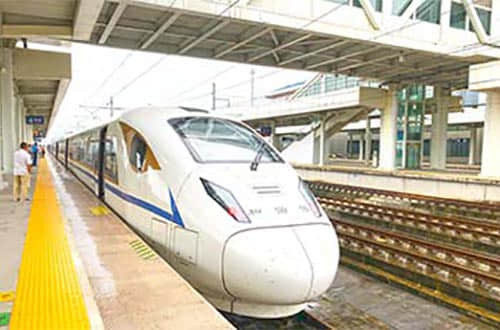 How to Take a Train in China
How to Take a Train in China 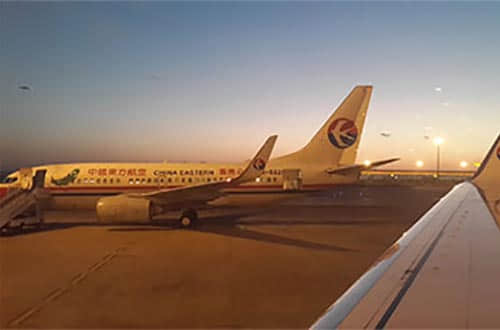 Why are Chinese Flights Always Delayed?
Why are Chinese Flights Always Delayed? 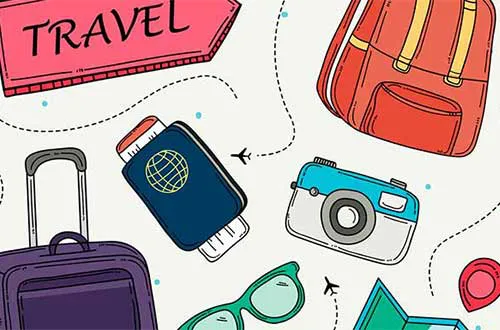 Summary of China Travel Tips
Summary of China Travel Tips 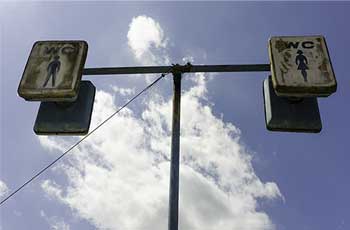 Toilets and Traveling
Toilets and Traveling